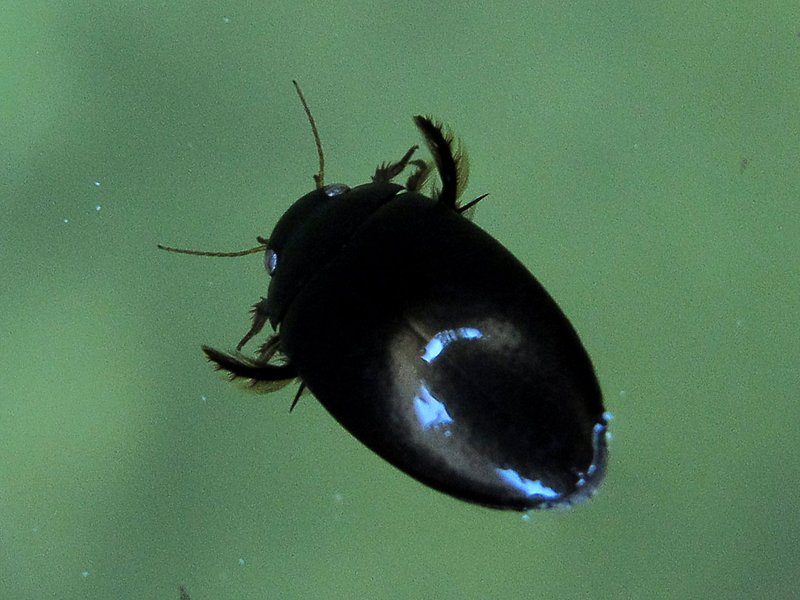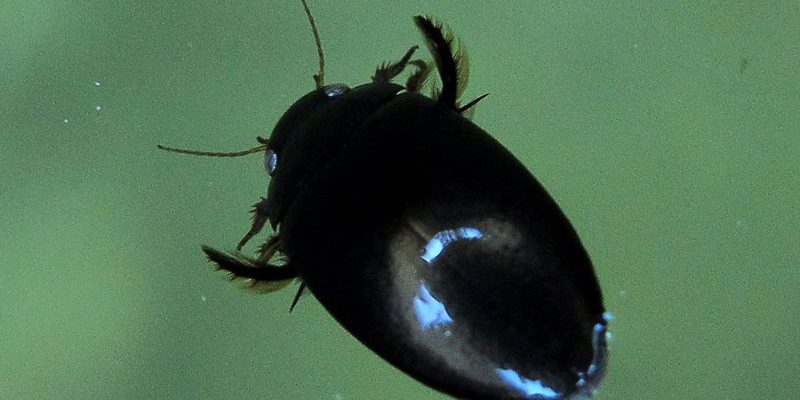
Imagine a tiny, spirited swimmer zooming around on the surface of a pond. That’s the Whirligig Beetle for you! With their dazzling speed and curious habits, these little creatures have a way of captivating anyone who stumbles upon them. Native to many regions across the globe, these beetles often draw attention not just for their playful movements but also for their intriguing lifestyles.
As you watch them spin and swirl, you might find yourself wondering what makes these beetles so unique. Why do they dart across the water like they’ve got a secret? And what do they actually eat while doing their little dance? In this article, we’re diving into the world of Whirligig Beetles to uncover the mysteries of their fascinating lives.
What is a Whirligig Beetle?
Whirligig Beetles belong to the family Gyrinidae, a group renowned for their distinctive swimming style. These beetles hold an impressive reputation for their agility, often appearing as if they’re performing a synchronized swim routine. Typically, they measure between 5 to 20 millimeters in length, and their glossy black or brown bodies are adorned with a smooth, streamlined shape that helps them glide effortlessly across the water surface.
These beetles have several unique features. One of the most interesting aspects is their compound eyes, which are divided. This means they can see both above and below the water simultaneously, making it easier for them to spot predators and prey alike. Such adaptations allow the Whirligig Beetle to thrive in various freshwater habitats, from ponds and lakes to slow-moving streams.
Habitat
Whirligig Beetles love calm waters. You’ll usually find them floating on the surface of lakes, ponds, and slow streams. The clear, still water is their playground, providing a safe place to hunt and play. They thrive in environments rich with aquatic plants since these plants offer shelter from predators and a perfect spot to hide their eggs.
Interestingly, these beetles are not strictly tied to one type of water body. They can adapt to various conditions, but they generally prefer shallow waters where they can easily dart around and feed. If you ever find yourself near a pond, take a moment to look closely at the surface. You might just spot a Whirligig Beetle twirling about!
Diet and Feeding Habits
When it comes to food, Whirligig Beetles are not picky eaters. They primarily feast on small insects and larvae that fall onto the water’s surface. Think of them as nature’s scavengers, helping to keep the ecosystem in check by feeding on these tiny creatures. They don’t just stop at insects, though; you might also find them nibbling on plant material or even eating dead aquatic animals.
Feeding happens primarily on the surface of the water, where they can easily snatch up passing prey. With their swift movements and keen eyesight, they can quickly dart in and out to catch their meals without much effort. This makes them fascinating to watch. It’s like seeing a well-rehearsed performance unfold right before your eyes!
Life Cycle and Reproduction
The life cycle of a Whirligig Beetle is both captivating and complex. It starts when the adult female lays her eggs on the underside of leaves, usually floating near the water’s edge. Once the eggs hatch, the larvae live in the water, where they hunt for food until they mature. This stage is crucial, as the larvae resemble tiny, elongated versions of their parents and are ferocious predators themselves.
This transformation from larva to adult is known as metamorphosis. It’s a fascinating process that showcases nature’s ability to adapt and thrive in different environments. After a few weeks, the larvae will pupate, eventually emerging as adult Whirligig Beetles ready to take on the world. As adults, they are quick to find mates and continue the cycle, ensuring the survival of their unique lineage.
Behavioral Traits
What truly sets the Whirligig Beetle apart is its distinctive behavior. Known for their spinning and swirling antics, these beetles are social creatures. You’ll often see them gathered in groups, darting about in mesmerizing patterns. This playful display is not just for show; it’s also a way to attract potential mates and establish territory.
Another fascinating aspect of their behavior is their ability to sense danger. With those remarkable compound eyes, they can quickly detect approaching threats, whether it’s a hungry fish or a curious human. When alarmed, they dive underwater, using their rapid swimming skills to escape. This quick escape is quite similar to how you might duck behind a tree if a squirrel suddenly appeared!
Table of Interesting Facts
| Size: | 5-20 mm |
| Habitat: | Ponds, lakes, and slow streams |
| Diet: | Small insects, larvae, and decaying plant material |
| Speed: | Fast swimmers, can dart quickly across water |
| Lifespan: | 1-2 years |
| Metamorphosis: | Egg, larva, pupa, adult stages |
Predators and Threats
While the Whirligig Beetle is an agile swimmer, it still has its fair share of predators. Fish, birds, and other aquatic creatures view these beetles as tasty snacks. Because they spend most of their lives on the water’s surface, they need to be vigilant. The dazzling display of their movements isn’t just playful; it’s also a survival tactic to confuse potential predators.
However, they are also threatened by habitat destruction. Pollution and the draining of wetlands can severely impact their populations. When we lose lakes and ponds, we lose not just the Whirligig Beetles, but the entire ecosystem that thrived in those waters. It’s a reminder that every small creature, no matter how insignificant it may seem, plays a vital role in nature.
Fun Facts about Whirligig Beetles
Did you know that Whirligig Beetles are excellent divers? When they sense danger, they can swim underwater for extended periods using special air bubbles trapped by their bodies. This allows them to hide effectively until the coast is clear.
Another fun fact is their unique mating dance. During the mating season, the males will showcase their agility to attract females. It’s quite the performance, reminiscent of wildlife documentaries where animals flaunt their skills to win over a mate. Watching this can be quite entertaining!
Conservation Status
While many Whirligig Beetles thrive in their natural habitats, some species are facing threats due to habitat loss and pollution. The conservation status of various species can vary, but many are not currently endangered. Nonetheless, it’s essential to pay attention to their environments. Protecting wetlands and clean water sources is crucial for their survival.
As we continue to learn about these incredible creatures, awareness of their existence and the importance of biodiversity becomes key. By conserving their habitats, we’re not just safeguarding the Whirligig Beetle but also hundreds of other species that share the same ecosystem. Remember, every little effort counts!
FAQ
Where can I find Whirligig Beetles?
You can find Whirligig Beetles in calm, freshwater habitats like ponds, lakes, and slow-moving streams. They enjoy areas with plenty of aquatic plants, which provide shelter and food. If you’re near such water bodies during warm months, keep an eye on the surface; you’re likely to spot them swirling around.
Are Whirligig Beetles harmful to humans?
No, Whirligig Beetles are harmless to humans. They don’t sting or bite and generally avoid contact with people. Their diet consists mainly of small insects and larvae, so they’re more focused on their activities in the water than causing any trouble for us. They are a fascinating part of our ecosystem!
How fast can Whirligig Beetles swim?
Whirligig Beetles are impressively agile swimmers. They can dart across the water’s surface at remarkable speeds, although exact speeds are hard to measure. Their body structure allows them to move quickly to escape predators or catch their prey, making them quite the efficient little predators!
What do Whirligig Beetles look like?
Whirligig Beetles typically have smooth, shiny bodies that are primarily black or brown. They are small, measuring between 5 to 20 millimeters in length. Their unique eyes, which are split into two parts, help them see both above and below water at the same time. This adaptation is quite remarkable and aids in their survival.
Do Whirligig Beetles make sounds?
Whirligig Beetles do not produce sounds like some insects. Their communication primarily happens through visual displays and movement. Their swirling and spinning behavior is a crucial part of attracting mates and establishing dominance among other beetles.
What plants do Whirligig Beetles prefer near their habitat?
Whirligig Beetles are often found near aquatic plants like water lilies, duckweed, and various algae. These plants provide excellent hiding spots from predators and serve as a habitat for their prey. Ensuring healthy aquatic plant life is vital for their survival and overall ecosystem health.
How long do Whirligig Beetles live?
Whirligig Beetles typically have a lifespan of about 1 to 2 years, depending on environmental conditions and availability of food. Like many insects, their life cycle includes stages of egg, larva, pupa, and adult, with the majority of their life spent as adults swimming around and feeding.
Can you keep Whirligig Beetles as pets?
While it’s technically possible to keep Whirligig Beetles in a controlled environment, they require specific habitat conditions to thrive. You would need to create a setup that mimics their natural habitat closely, including clean water, aquatic plants, and a varied diet. They’re best appreciated in their natural surroundings!
Are Whirligig Beetles social creatures?
Yes! Whirligig Beetles are known to be social insects. You’ll often see them swimming in groups, engaging in playful interactions with each other. This social behavior plays a role in their mating rituals and territorial displays, making them quite fascinating to observe!
How do I help protect Whirligig Beetles?
One way to help protect Whirligig Beetles is by advocating for clean water and healthy wetlands. Reducing pollution and supporting conservation efforts can make a significant impact. Additionally, educating others about the importance of these beetles and their habitats can contribute to their protection. Every small action counts!
What role do Whirligig Beetles play in the ecosystem?
Whirligig Beetles play a vital role in their freshwater ecosystems. They help control insect populations by preying on smaller insects and larvae. Additionally, by feeding on decaying matter, they contribute to the breakdown of organic material, aiding in nutrient cycling. Their presence signifies a healthy water habitat!

